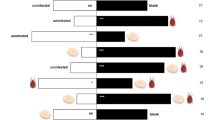Abstract
The ovipositional response of a Rutaceae-feeding papilionid butterfly,Papilio protenor, toCitrus host plants was evoked by the synergistic action ofl-(−)-stachydrine,d-(−)-quinic acid, (−)-synephrine, andl-(−)-proline that characterize the chemical compositions of the leaves and epicarp ofCitrus plants (C. natsudaidai andC. unshiu). The stimulatory activity of their mixture was enhanced by the addition of flavanone glycosides, naringin and hesperidin, which coexist in these plants and have previously been demonstrated to serve as oviposition stimulants. However, sugars such as sucrose, glucose, and inositols, which abound in plant tissues, exerted no effect on egg-laying by the females. On the other hand, chlorogenic acid present in the leaves of another host plant,Fagara ailanthoides, was found to act as an excellent synergist. However, there existed significant qualitative dissimilarities between the chemical compositions of the leaves ofC. unshiu andF. ailanthoides. This strongly suggests thatP. protenor is likely to utilize different categories of compounds as chemical cues in recognizing each plant as a host.
Similar content being viewed by others
References
Abe, H., Teramoto, Y., andIchinosé, T. 1981. Relationship between host plant ranges of the three papilionid butterflies and oviposition-inducing contact chemicals in their host plants.Appl. Entomol. Zool. 16:493–496.
Chew, F.S., andRobbins, R.K. 1984. Egg-laying in butterflies, pp. 65–79,in R.I. Vane-Wright, and P.R. Ackery (eds.). The Biology of Butterflies. Academic Press, New York. 429 pp.
David, W.A.L., andGardiner, B.O.C. 1962. Oviposition and hatching of the eggs ofPieris brassicae in a laboratory culture.Bull. Entomol. Res. 53:91–109.
Feeny, P., Rosenberry, L., andCarter, M. 1983. Chemical aspects of oviposition behavior in butterflies, pp. 27–76,in S. Ahmad (ed.). Herbivorous Insects: Host-Seeking Behavior and Mechanisms. Academic Press, New York. 257 pp.
Feeny, P., Sachdev, K., Rosenberry, L., andCarter, M. 1988. Luteolin 7-O-(6″-O-malonyl)-β-d-glucoside and trans-chlorogenic acid: Oviposition stimulants for the black swallowtail butterfly.Phytochemistry 27:3439–3448.
Honda, K. 1986. Flavanone glycosides as oviposition stimulants in a papilionid butterfly,Papilio protenor.J. Chem. Ecol. 12:1999–2010.
Ichinosé, T., andHonda, H. 1978. Ovipositional behavior ofPapilio protenor demetrius Cramer and the factors involved in its host plants.Appl. Entomol. Zool. 13:103–114.
Ma, W.C., andSchoonhoven, L.M. 1973. Tarsal contact chemosensory hairs of the large white butterfly,Pieris brassicae and their possible role in oviposition behaviour.Entomol. Exp. Appl. 16:343–357.
Moore, G.J. 1986. Host plant discrimination in tropical satyrine butterflies.Oecologia 70:592–595.
Namba, T., Araki, I., Mikage, M., andHattori, M. 1985. Fundamental studies on the evaluation of crude drugs. VIII. Monthly variations in anatomical characteristics and chemical components of the dried fruit peels ofCitrus unshiu, C. aurantium andC. natsudaidai.Shoyakugaku Zasshi 39:52–62.
Nishida, R. 1977. Oviposition stimulants of some papilionid butterflies contained in their host plants.Botyu-Kagaku 42:133–140 (in Japanese).
Nishida, R., Ohsugi, T., Kokubo, S., andFukami, H. 1987. Oviposition stimulants of aCitrus- feeding swallowtail butterfly,Papilio xuthus L.Experientia 43:342–344.
Nishiura, M., Esaki, S., andKamiya, S. 1969. Flavonoids inCitrus and related genera. Part I. Distribution of flavonoid glycosides inCitrus andPoncirus.Agric. Biol. Chem. 33:1109–1118.
Ohsugi, T., Nishida, R., andFukami, H. 1985. Oviposition stimulant ofPapilio xuthus, aCitrus- feeding swallowtail butterfly.Agric. Biol. Chem. 49:1897–1900.
Pereyra, P.C., andBowers, M.D. 1988. Iridoid glycosides as oviposition stimulants for the buckeye butterfly,Junonia coenia (Nymphalidae).J. Chem. Ecol. 14:917–928.
Rausher, M.D. 1978. Search image for leaf shape in a butterfly.Science 200:1071–1073.
Renwick, J.A.A., andRadke, C.D. 1983. Chemical recognition of host plants for oviposition by the cabbage butterfly,Pieris rapae (Lepidoptera: Pieridae).Environ. Entomol. 12:446–450.
Renwick, J.A.A., andRadke, C.D. 1987. Chemical stimulants and deterrents regulating acceptance or rejection of crucifers by cabbage butterflies.J. Chem. Ecol. 13:1771–1776.
Renwick, J.A.A., andRadke, C.D. 1988. Sensory cues in host selection for oviposition by the cabbage butterfly,Pieris rapae.J. Insect Physiol. 34:251–257.
Rodman, J.E., andChew, F.S. 1980. Phytochemical correlates of herbivory in a community of native and naturalized Cruciferae.Biochem. Syst. Ecol. 8:43–50.
Saxena, K.N., andGoyal, S. 1978. Host-plant relations of the citrus butterflyPapilio demoleus L.: Orientational and ovipositional responses.Entomol. Exp. Appl. 24:1–10.
Stanton, M.L. 1979. The role of chemotactile stimuli in the oviposition preferences ofColias butterflies.Oecologia 39:79–91.
Stanton, M.L. 1982. Searching in a patchy environment: Food plant selection byColias p. eriphyle butterflies.Ecology 63:839–853.
Stewart, I., Newhall, W.F., andEdwards, G.J. 1964. The isolation and identification of 1-synephrine in the leaves and fruit ofCitrus.J. Biol. Chem. 239:930–932.
Tabashnik, B.E., Wheelack, H., Rainbolt, J.D., andWatt, W.B. 1981. Individual variation in oviposition preference in the butterfly,Colias eurytheme.Oecologia 50:225–230.
Thompson, J.N. 1988. Variation in preference and specificity in monophagous and oligophagous swallowtail butterflies.Evolution 42:118–128.
Tosa, S., Ishihara, S., Toyota, M., Yoshida, S., Nakazawa, H., andTomimatsu, T. 1988. Studies of flavonoid inCitrus. Analysis of flavanone glycosides in the peel ofCitrus by high performance liquid chromatography.Shoyakugaku Zasshi 42:41–47 (in Japanese).
Vaidya, V.G. 1969. Investigations of the role of visual stimuli in egg-laying and resting behavior ofPapilio demoleus L. (Papilionidae, Lepidoptera).Anim. Behav. 17:350–355.
Wiklund, C. 1981. Generalist vs. specialist oviposition behaviour inPapilio machaon (Lepidoptera) and functional aspects on the hierarchy of oviposition preferences.Oikos 36:163–170.
Author information
Authors and Affiliations
Rights and permissions
About this article
Cite this article
Honda, K. Identification of host-plant chemicals stimulating oviposition by swallowtail butterfly,Papilio protenor . J Chem Ecol 16, 325–337 (1990). https://doi.org/10.1007/BF01021768
Received:
Accepted:
Issue Date:
DOI: https://doi.org/10.1007/BF01021768




